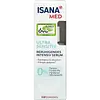What's inside
What's inside
 Key Ingredients
Key Ingredients

 Benefits
Benefits

 Concerns
Concerns

No concerns
 Ingredients Side-by-side
Ingredients Side-by-side

Water
Skin ConditioningPentylene Glycol
Skin ConditioningGlycerin
HumectantPolyglyceryl-6 Stearate
EmollientButyrospermum Parkii Butter
Skin ConditioningCoco-Caprylate
EmollientDicaprylyl Ether
EmollientHydrogenated Vegetable Glycerides
EmollientPrunus Amygdalus Dulcis Oil
Skin ConditioningTocopheryl Acetate
AntioxidantOenothera Biennis Oil
EmollientPanthenol
Skin ConditioningEthylhexylglycerin
Skin ConditioningXanthan Gum
EmulsifyingAllantoin
Skin ConditioningHelianthus Annuus Seed Oil
EmollientTocopherol
AntioxidantCitric Acid
BufferingPantolactone
HumectantWater, Pentylene Glycol, Glycerin, Polyglyceryl-6 Stearate, Butyrospermum Parkii Butter, Coco-Caprylate, Dicaprylyl Ether, Hydrogenated Vegetable Glycerides, Prunus Amygdalus Dulcis Oil, Tocopheryl Acetate, Oenothera Biennis Oil, Panthenol, Ethylhexylglycerin, Xanthan Gum, Allantoin, Helianthus Annuus Seed Oil, Tocopherol, Citric Acid, Pantolactone
Water
Skin ConditioningGlycerin
HumectantOryza Sativa Bran Oil
EmollientTocopheryl Acetate
AntioxidantOctyldodecanol
EmollientOrbignya Oleifera Seed Oil
EmollientGlyceryl Stearate Citrate
EmollientCetyl Alcohol
EmollientDicaprylyl Ether
EmollientPanthenol
Skin ConditioningGlyceryl Stearate
EmollientCaprylyl Glycol
EmollientXanthan Gum
EmulsifyingEctoin
Skin ConditioningAllantoin
Skin ConditioningCaprylhydroxamic Acid
Ubiquinone
AntioxidantSodium Hyaluronate
HumectantHydrolyzed Sodium Hyaluronate
Skin ConditioningTocopherol
AntioxidantWater, Glycerin, Oryza Sativa Bran Oil, Tocopheryl Acetate, Octyldodecanol, Orbignya Oleifera Seed Oil, Glyceryl Stearate Citrate, Cetyl Alcohol, Dicaprylyl Ether, Panthenol, Glyceryl Stearate, Caprylyl Glycol, Xanthan Gum, Ectoin, Allantoin, Caprylhydroxamic Acid, Ubiquinone, Sodium Hyaluronate, Hydrolyzed Sodium Hyaluronate, Tocopherol
Ingredients Explained
These ingredients are found in both products.
Ingredients higher up in an ingredient list are typically present in a larger amount.
Allantoin is a soothing ingredient known for its protective and moisturizingg properties. Because of this, it is often added to products with strong active ingredients.
Studies show higher concentrations of this ingredient can promote wound healing.
Though it can be derived from the comfrey plant, allantoin is produced synthetically for cosmetic products to ensure purity.
Learn more about AllantoinDicaprylyl Ether is created from caprylic acid. It is a texture-enhancer and emollient.
As an emollient, Dicaprylyl Ether is non-comedogenic. It helps soften and smooth the skin by creating a barrier on top. This barrier helps trap moisture in, helping to hydrate the skin.
Dicaprylyl Ether gives a non-greasy feel and better spreadability to products.
Learn more about Dicaprylyl EtherGlycerin is already naturally found in your skin. It helps moisturize and protect your skin.
A study from 2016 found glycerin to be more effective as a humectant than AHAs and hyaluronic acid.
As a humectant, it helps the skin stay hydrated by pulling moisture to your skin. The low molecular weight of glycerin allows it to pull moisture into the deeper layers of your skin.
Hydrated skin improves your skin barrier; Your skin barrier helps protect against irritants and bacteria.
Glycerin has also been found to have antimicrobial and antiviral properties. Due to these properties, glycerin is often used in wound and burn treatments.
In cosmetics, glycerin is usually derived from plants such as soybean or palm. However, it can also be sourced from animals, such as tallow or animal fat.
This ingredient is organic, colorless, odorless, and non-toxic.
Glycerin is the name for this ingredient in American English. British English uses Glycerol/Glycerine.
Learn more about GlycerinPanthenol is a common ingredient that helps hydrate and soothe the skin. It is found naturally in our skin and hair.
There are two forms of panthenol: D and L.
D-panthenol is also known as dexpanthenol. Most cosmetics use dexpanthenol or a mixture of D and L-panthenol.
Panthenol is famous due to its ability to go deeper into the skin's layers. Using this ingredient has numerous pros (and no cons):
Like hyaluronic acid, panthenol is a humectant. Humectants are able to bind and hold large amounts of water to keep skin hydrated.
This ingredient works well for wound healing. It works by increasing tissue in the wound and helps close open wounds.
Once oxidized, panthenol converts to pantothenic acid. Panthothenic acid is found in all living cells.
This ingredient is also referred to as pro-vitamin B5.
Learn more about PanthenolTocopherol (also known as Vitamin E) is a common antioxidant used to help protect the skin from free-radicals and strengthen the skin barrier. It's also fat soluble - this means our skin is great at absorbing it.
Vitamin E also helps keep your natural skin lipids healthy. Your lipid skin barrier naturally consists of lipids, ceramides, and fatty acids. Vitamin E offers extra protection for your skin’s lipid barrier, keeping your skin healthy and nourished.
Another benefit is a bit of UV protection. Vitamin E helps reduce the damage caused by UVB rays. (It should not replace your sunscreen). Combining it with Vitamin C can decrease sunburned cells and hyperpigmentation after UV exposure.
You might have noticed Vitamin E + C often paired together. This is because it is great at stabilizing Vitamin C. Using the two together helps increase the effectiveness of both ingredients.
There are often claims that Vitamin E can reduce/prevent scarring, but these claims haven't been confirmed by scientific research.
Learn more about TocopherolTocopheryl Acetate is AKA Vitamin E. It is an antioxidant and protects your skin from free radicals. Free radicals damage the skin by breaking down collagen.
One study found using Tocopheryl Acetate with Vitamin C decreased the number of sunburned cells.
Tocopheryl Acetate is commonly found in both skincare and dietary supplements.
Learn more about Tocopheryl AcetateWater. It's the most common cosmetic ingredient of all. You'll usually see it at the top of ingredient lists, meaning that it makes up the largest part of the product.
So why is it so popular? Water most often acts as a solvent - this means that it helps dissolve other ingredients into the formulation.
You'll also recognize water as that liquid we all need to stay alive. If you see this, drink a glass of water. Stay hydrated!
Learn more about WaterXanthan gum is used as a stabilizer and thickener within cosmetic products. It helps give products a sticky, thick feeling - preventing them from being too runny.
On the technical side of things, xanthan gum is a polysaccharide - a combination consisting of multiple sugar molecules bonded together.
Xanthan gum is a pretty common and great ingredient. It is a natural, non-toxic, non-irritating ingredient that is also commonly used in food products.
Learn more about Xanthan Gum